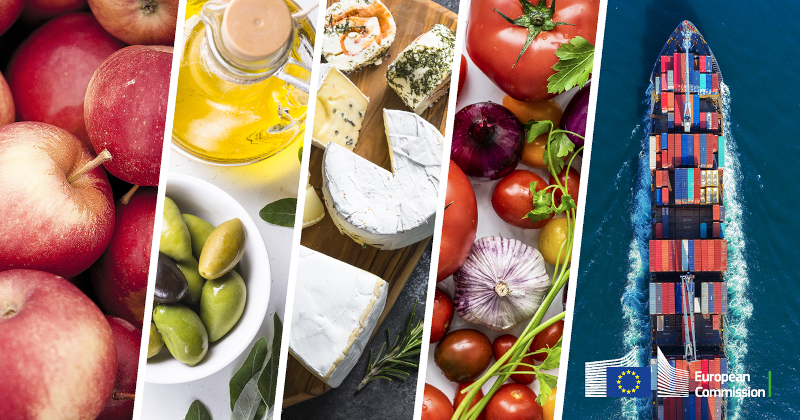
In August 2024, the EU agri-food trade surplus reached €5.2 billion despite a slight decrease compared to July 2024. The surplus from January to August 2024 amounted to €44.8 billion, which is €431 million higher than the same period in 2023 thanks to the strong start of EU exports at the beginning of the year. The EU agri-food sector continues to deliver a solid performance at the international level. These are the main findings of the latest monthly agri-food trade report published today by the European Commission.
This monthly publication is accompanied by a thematic study on historical trade flows between the EU, Canada, and Japan.
Exports
EU agri-food exports reached €18.6 billion in August 2024, down 10% from July but 1% higher than August 2023. Cumulative exports from January to August rose to €155.8 billion, a +2% increase compared to the same period in 2023.
The United Kingdom remained the EU’s top agri-food export destination from January to August 2024, with exports valued at €35.1 billion (+3%), followed by the United States at €19.6 billion (+10%), driven by higher prices and volumes of key products like olives and olive oil. In contrast, exports to China and Russia declined significantly. For China, this is explained in particular by reductions in exports of pigmeat, cereals, and dairy products.
Exports of olives and olive oil saw the largest increase, rising by €1.8 billion (+58%) thanks to high prices. In contrast, cereal exports fell by €1.3 billion (-13%) in value due to lower prices but volumes exported increased by +6%. The increase in exported volumes of sugar and isoglucose reached +184%, making the EU a net exporter again.
Imports
EU agri-food imports reached €13.4 billion in August 2024, down 8% from July 2024 but +23% higher than August 2023. Cumulative imports from January to August added up to €111 billion, a +3% increase compared to the same period in 2023.
Brazil remained the top source of EU imports between January and August, despite a 5% decline due to lower oilseeds prices and cereals volumes. Côte d’Ivoire, Nigeria, and Tunisia showed significant increases driven by higher prices for cocoa and olive oil, while imports from Australia had the largest reduction (-38%) due to reduced rapeseed volumes and prices.
EU imports of coffee, tea, cocoa, and spices increased by €4.6 billion (+33%) compared to 2023 due to rising cocoa prices. Imports of olives and olive oil grew by €654 million (+93%) since January driven by both higher volumes and prices. In contrast, imports of oilseeds and protein crops fell by €1.9 billion (-13%) compared to 2023 due to lower prices, and cereals imports dropped by €1.6 billion (-20%) mainly because of reduced prices.
More insights as well as detailed tables are available below in the latest edition of the monthly EU agri-food trade report.
New study on the EU agri-food trade with Canada and Japan
In addition to the regular monthly agrifood trade report, the Commission also publishes today a new study looking into the evolution of EU agri-food trade since the implementation of the EU-Canada Comprehensive Economic and Trade Agreement (CETA) and the EU-Japan Economic Partnership Agreement (EPA). The study connects data on market access provided by each agreement with changes in trade flows, analysed at a detailed product level. The two free trade agreements examined show a clear rise in bilateral agri-food trade for products benefiting from preferential access, such as duty-free tariffs, reduced tariffs, or tariff rate quotas.
The Commission monitors closely and in all transparency its trade agreements and their implementation across all sectors. In addition to providing valuable data, this allows to preempt and prevent any potential market disturbance and protect the interests of all EU producers.
For the CETA, both European and Canadian exports grew at similar rates after the CETA started to be provisionally implemented. This resulted in a positive trade balance for the EU agrifood sector of €2.1 billion in 2023. The market shares of EU exports with a preferential access to the Canadian market grew by 14%, corresponding to an additional €400 million of EU exports, in particular in animal products, wine, beverages and food preparations.) Imports from Canadian origin with a preferential treatment increased in lower amounts (+250 million EUR, notably in confectionery and chocolate, as well as ethanol).
For the EPA with Japan, EU exports with preferential access have grown by an estimated €267 million since the EPA came into force, reaching a +4% growth in market share in the Japanese market, across a range of products. The EU agrifood sector has a positive trade balance with Japan worth €9.1 billion in 2023. Some tariffs, however, are still being phased out, which could lead to greater trade potential in the future. Imports from Japanese origin with preferential treatment increased in lower amounts (+95 million EUR, mainly in mixed food preparations).
Details
- Publication date
- 28 November 2024
- Author
- Directorate-General for Agriculture and Rural Development
- Location
- Brussels




